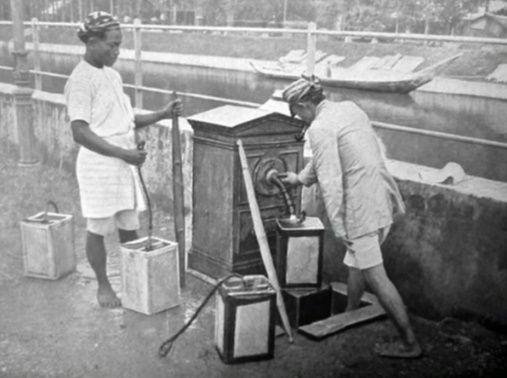Quite the problem with Indonesian Government is they care to much about symbolic nationalism than accepting the fact that We have a problem, they much rather keep up a good face than receive massive criticism but actually fixes issues.
Rip up all the concrete, dump it all along the sea wall as reinforcing...allows rainfall to go back to the aquifer, then start major pipe installations for everyone from reservoirs, not aquifers. Aqueducts could help. They were pre roman...so easy build. Make them of invulnerable concrete using the volcanic ash sand.

Why am I crying, suddenly all the memories I’ve had in Jakarta with my loved ones are replaying like a movie. thinking that one day, all of this could be gone. some people maybe moved to another city, and resulting in my loved ones. best of luck, Jakarta.
I live near Jakarta and many people here blame Bogor for the flood. but then I realize floods in my house come from both Jakarta and Bogor. it's really hard to live in rainy season, but dry season here feels as hot as hell's door.
This is Walden Mosque in Jakarta. Its roof is in ruins. Moss covers the walls. And sea water flows through every corner of it. The last time people prayed here was in 2001, back when it was above ground. Today, it’s a warning sign. Because, even though Jakarta faces the same sea rising levels as other coastal cities around the world, that’s not quite what we’re looking at here.
Jakarta is sinking. And it’s been sinking for decades. These blue areas show just how much the city has sunk since the 1970s. Hers how much its descended today. Most of the sinking happens here, in the north coast, where Jakarta meets the Java Sea. Here, the land is sinking by about 25 cm a year, destabilizing the area, damaging homes, and upending people’s lives, over and over again. Many residents here are fishermen, who need to live by the coast to make a living, but further inland, Jakarta’s more than 10 million residents are also at risk. It has 13 rivers that drain through it.
But the reason the city is sinking is actually that most people here don’t have enough water. Most Jakarta’s lack access to clean, piped water. Instead, they get their water by digging wells like this one. The pumps go deep into the ground to extract the water stored in aquifers, underground layers of rock that hold groundwater. The porous spaces of the rock are filled with it. Multiply this by a few million, and you have a problem. Think of the rock as a soaked sponge:

The more water is extracted, the more it deflates, Pumps alone shouldn’t be able to do this. While some layers of earth will never recover their water, aquifers are usually refilled naturally when it rains. But in Jakarta, that’s becoming increasingly rare.
For decades, Jakarta has been developing at a fast pace, and is now covered in concrete. It’s gotten so bad that in coastal areas prone to flooding, like the fishing community Muara Baru, people have built makeshift bridges to move through their neighborhoods. Combined with sea level rise, it’s also made floods during high tide and rainy seasons much more dangerous.
Like in 2007, when Jakarta experienced one of the worst floods in its modern history. killing 80 people. Maksim has already lost his home to the sinking, and now sleeps on his fishing boat. And Mondo has had to rebuild his home several times. Groundwater pumping is putting Jakarta’s survival at risk. But to understand how it got into this situation to begin with, you have to go back centuries.
In the 1600s, when European powers were colonizing the world, the Dutch took over what was then the port town of Jakarta. They razed it to the ground, and in its place, built Batavia: a headquarters for their growing empire. They began to rule over the Indonesian, and built their new city in the Dutch style, with narrow townhouses along a grid of canals. The canals were used for trade, defense, and to make Batavia feel like a Dutch city. But look at Batavia from above, and you can see the city grid served a darker purpose, too.
Between the two sides, or between the blocks. This was by design. The Dutch were outnumbered. So, in order to control the local population, they divided it. It looked like this. Pretty much every group was confined to their city quarter and sediment from earthquakes blocked the flow of water. As disease spread through the canals, the wealthier Dutch moved south of Batavia, where they began to develop a new colonial administrative center. But, despite the death and disease, the Dutch continued to leave the canals untreated. Instead, they began to use piped water.
In the 1870s, they developed the first centralized water supply, with iron pipes to distribute water to homes. The pipes provided clean drinking water and indoor bathrooms. But the pipes were concentrated in these areas, where the Dutch had moved to. The indigenous population was left in informal settlements, called kampongs, far from the piped water. And this created a new kind of division in the city. Native residents had to rely on street vendors for water. But most often, they were forced to get their water from the neglected canals.
It took decades before pipes were finally built in these communities. And when they were, it would only be a few public standpipes. This continued through 1949. After an armed conflict, the Dutch finally recognized Indonesia’ independence, and left. Built on marshland, and segregated by water access, that, now, Jakarta’s had to deal with. Over the next decades, Jakarta’s population skyrocketed. More people required more housing, more stores, and more streets. And the city expanded fast. But its water infrastructure still doesn’t serve the majority of the city.

The problem is that, just like the rest of Jakarta, the seawall is sinking. The project also includes an ambitious $40 billion plan to build a 38 km wall, shaped like a massive bird, to protect the coast from flooding. And by then, Jakarta could have lost most of its coastal land.
Jakarta will continues to sink until groundwater stops being pumped. And groundwater will continue to be pumped until the government provides an alternative. This has been done before. In the 1950s, Tokyo managed to stop severe sinking by providing piped water. Taipei, Shanghai, Bangkok, are other cities in the region that have managed to stop their cities from sinking. But time is running out. And restricted its water, plagues it to this day. Jakarta is sinking into the sea. And, until its government figures out how to provide clean, piped water for its citizens, that will continue to be its reality. For as long as it’s still here.
